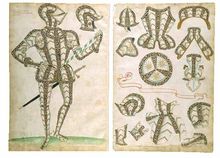Armor

An armor ( mhd. Harnasch , from old French harnais ; originally probably from the old Norse * hernest "army supply") is the armor of a knight that covers the body . Horse harnesses and elephant harnesses were also made .
Development of meaning
Originally, the name was applied to the entire equipment (full armor) of a knight. Around 1200 the meaning changed and the harnasch was only the part of the armor intended to protect the upper body.
In the High Middle Ages , the armor was also called “ Brünne ”, “Halsberc” or “Haubert” chain armor , which developed through various mixed forms into late medieval and early modern plate armor . Such armor was made by an armorer and then polished or etched by a harness sweeper.
Typology
Harnisch is a collective term for protective weapons within the group of armors that are used to cover the body. Subgroups of harnesses have developed in different time periods, cultures and usage-related. In particular, the following are known:
- Half armor a group of armor used by foot soldiers and horsemen.
Examples of other prehistoric, ancient, medieval and early modern armaments:
- Textile armor
- Leather armor
- Bell armor
- Flap armor
- Muscle armor
- Lamellar armor
- Scale armor
- Chain armor
- Rail or clasp armor
- Brigantine
- Record skirt
- Plate armor
- Piercing and racing gear
- Japanese armor ( Yoroi )
- Step armor made of silk ( Mongolian warfare )
Especially since the late Middle Ages , plate armor that was suitable for a specific use emerged, see: Types of plate armor .
Web links
literature
- Joachim Bumke : Court culture. Literature and Society in the High Middle Ages (= dtv 4442). 2 volumes. Deutscher Taschenbuch-Verlag, Munich 1986, ISBN 3-423-04442-X .

